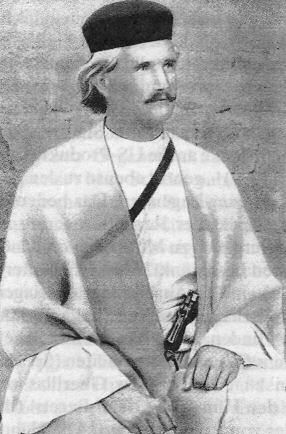
A diplomat who attempted to foment a Muslim uprising against the British in the Middle East, Wilhelm Wassmuss was born in Salzgitter-Ohlendorf (Lower Saxony) on 14 February 1880. He joined the German Foreign Office as a translator in 1906 and became the consul in Bushire, Persia (Iran), six years later. Because of his fluency in Persian (Farsi) and Arabic, his travels among the tribes of southern Persia, and his hardened personality, Wassmuss was selected for a joint Turkish and German mission designed to bring Persia and Afghanistan into World War I. His role was to lead the German group—numbering several dozen men—and handle the diplomatic negotiations with the Afghans. Second in command was Oskar von Niedermayer, who had also traveled extensively in the region. To disguise their expedition as it passed through neutral Romania, they posed as a traveling circus troupe, although their equipment was detected by a customs inspector and had to be replaced.
In January 1916, after dissension arose between the Turks and the Germans as well as in the ranks of Wassmuss’s team, he handed the command to Niedermayer and departed on his own, clad in Persian garb and posing as a Muslim. His objective was to reconnect with tribal leaders he knew in southern Persia and convince them to embark on a holy war, forcing the British to commit their limited troops to that region. On 5 March, he and two companions were captured by a group of horsemen in the pay of the British. Wassmuss escaped but had to leave behind a crucial German diplomatic codebook, which the British later used to help decipher the Zimmermann Telegram. His plan to extend the anti-British campaign to India also had to be abandoned because of the loss of specially prepared incendiary leaflets.
After establishing a base of operations in Shiraz, he resumed contact with his principal allies, the bellicose Tangistani tribesmen, but proved unable to lure the leaders of the Bakhtiári into hostilities against the British. A bounty for Wassmuss’s capture was proposed by Percy Cox, the chief British political officer in Basra, but was overruled by the Foreign Office in London. When the Tangistani attacked the British residency in Bushire in July, they were repulsed. Wassmuss’s focus then shifted to Isfahan, the new base of operations, and Kermanshah, which controlled the supply route from Baghdad into the country. He next targeted the small, isolated British consulate in Shiraz relying on the local gendarmerie, which was sympathetic to his efforts. The British commander, Frederick O’Connor, and his staff were easily captured and were to be traded for Germans being held in India. Yet in the process of negotiating with the British, Wassmuss unknowingly let O’Connor, a former Indian Army intelligence officer, communicate with his superiors in Bushire employing a secret code. These officials approached the Tangistani and offered to trade fellow tribesmen held prisoners for the British hostages. When the exchange finally took place on 10 August 1916, Wassmuss vented his deep frustration that his plan regarding the German hostages had been thwarted. He remained at large in Persia for the remainder of the war, proving to be primarily a nuisance rather than a threat to British interests. O’Connor described him as a solitary figure living “in extreme simplicity in the native manner” and riding “continuously about the country, from place to place, from tribe to tribe, in every extreme of climate, and always at the mercy of these treacherous, fanatical people.”
Apprehended by Persian authorities in 1918 and transferred to the British in Tehran, Wassmuss escaped but was quickly recaptured. Despite demands for a trial for war crimes, he was permitted to return to Germany. Aware of his unfulfilled promises to the Tangistani, Wassmuss tried to bring modern farming techniques to the tribesmen and raise their standard of living. His attempt ended badly, and he again returned to Germany, dying impoverished in Berlin on 29 November 1931.